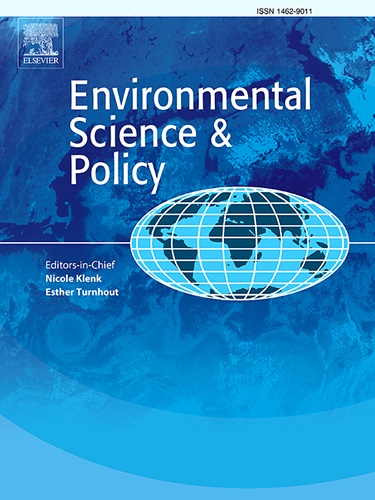Navigating the pathway from collaborative governance to impacts under uncertainty: A theory of change for watershed visions
IF 4.9
2区 环境科学与生态学
Q1 ENVIRONMENTAL SCIENCES
引用次数: 0
Abstract
Collaborative governance is considered effective in environmental problem solving. However, it is not always successful in delivering benefits. In Finland, collaborative ‘watershed visions’ are gaining popularity as a way to advance holistic water management. Watershed visions bring the public, private, and civil society actors across sectors together to agree on a desired future for a river basin and to plan steps for achieving it. The capability of watershed visions to lead to positive environmental impacts is, however, highly uncertain. We applied a Theory of Change approach to conceptualize an outcome-oriented impact pathway for the watershed visions to enhance the understanding of their possibilities to achieve their desired long-term impacts. Using empirical material, we structured a watershed vision process into an impact pathway of nine phases necessary for achieving the desired future. From each phase, we identified assumptions suggesting why and under what conditions the impact pathway successfully works, risks to its realization, and key uncertainties inherent to the risks. Focusing on the uncertainties, we developed a tool for ex-ante, interim, and ex-post evaluation of the watershed visions. We suggest that a longitudinal Theory of Change is a useful tool for addressing change and managing uncertainty in any collaborative process with long-term aims, and that applying this tool can increase the success of collaborative governance.
从合作治理到不确定情况下的影响:流域愿景的变革理论
合作治理被认为是解决环境问题的有效方法。然而,它并不总能成功带来效益。在芬兰,协作式 "流域愿景 "作为一种推进全面水管理的方法正日益受到欢迎。流域愿景将公共、私营和民间社会各部门的参与者聚集在一起,共同商定流域的理想未来,并规划实现这一目标的步骤。然而,流域愿景能否带来积极的环境影响还很不确定。我们采用了 "变化理论 "方法,为流域愿景构思了一条以结果为导向的影响途径,以加深对流域愿景实现其预期长期影响的可能性的理解。利用经验材料,我们将流域愿景流程构建为实现理想未来所需的九个阶段的影响途径。从每个阶段中,我们确定了影响途径成功运作的原因和条件、实现途径的风险以及风险所固有的关键不确定性。以不确定性为重点,我们开发了一种工具,用于对流域愿景进行事前、事中和事后评估。我们认为,在任何具有长期目标的合作过程中,纵向 "变化理论 "都是应对变化和管理不确定性的有用工具,应用这一工具可以提高合作治理的成功率。
本文章由计算机程序翻译,如有差异,请以英文原文为准。
求助全文
约1分钟内获得全文
求助全文
来源期刊

Environmental Science & Policy
环境科学-环境科学
CiteScore
10.90
自引率
8.30%
发文量
332
审稿时长
68 days
期刊介绍:
Environmental Science & Policy promotes communication among government, business and industry, academia, and non-governmental organisations who are instrumental in the solution of environmental problems. It also seeks to advance interdisciplinary research of policy relevance on environmental issues such as climate change, biodiversity, environmental pollution and wastes, renewable and non-renewable natural resources, sustainability, and the interactions among these issues. The journal emphasises the linkages between these environmental issues and social and economic issues such as production, transport, consumption, growth, demographic changes, well-being, and health. However, the subject coverage will not be restricted to these issues and the introduction of new dimensions will be encouraged.
 求助内容:
求助内容: 应助结果提醒方式:
应助结果提醒方式:


